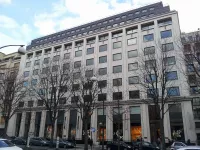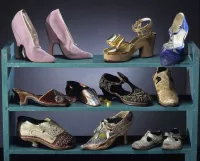Prada S.p.A. is an Italian luxury fashion house established in 1913 by Mario Prada in Milan. It specializes in leather handbags, travel accessories, shoes, ready-to-wear clothing, and other fashion accessories. Prada also licenses its brand to Luxottica for eyewear and to L’Oréal for fragrances and cosmetics.
1913: Fratelli Prada Founded in Milan
In 1913, Mario Prada and his brother Martino founded Fratelli Prada, a leather goods shop in Milan. The shop initially sold animal goods, imported English steamer trunks, and handbags, along with handcrafted leather goods, travel accessories, beauty cases, jewelry, luxury items, and rare objects.
1913: Company Foundation and Early Focus
In 1913, Mario Prada founded the company, named after his family. Initially, the company sold imported English animal goods. Later, under the leadership of Miuccia Prada and her husband, Patrizio Bertelli, the company transitioned to waterproof nylon fabrics in the 1970s. By the 1990s, Prada gained recognition as a luxury brand known for its original designs.
1970: Miuccia Prada Joins the Company
In 1970, Miuccia Prada joined the family business.
1977: Miuccia Prada Meets Patrizio Bertelli
In 1977, Miuccia Prada met Patrizio Bertelli, an Italian businessman, who later joined the company.
1978: Miuccia Inherits the Company
In 1978, Miuccia Prada inherited the company. By this time, sales had reached US$450,000. With Bertelli as business manager, Miuccia was able to implement her creativity into the company's designs.
1978: Miuccia Prada Takes Over the Company
In 1978, Miuccia Prada succeeded Luisa and took over the family business.
1979: Release of First Backpacks and Totes
In 1979, Miuccia Prada released her first set of backpacks and totes made from tough military spec black nylon. Initial sales were slow due to lack of advertising and high prices, but the line became a commercial hit.
1984: Expansion and Shoe Line Release
In 1984, the house of Prada began expansion across continental Europe and the United States. Locations were opened in Florence, Paris, Madrid, and New York City. A shoe line was also released.
1985: Release of the Classic Prada Handbag
In 1985, Miuccia Prada released the "classic Prada handbag," which became an overnight sensation. The handbag's sleek lines and craftsmanship established a signature of luxury for Prada.
1987: Miuccia and Bertelli Married
In 1987, Miuccia Prada and Patrizio Bertelli married.
1988: Launch of Women's Ready-to-Wear Collection
In 1988, Prada launched its women's ready-to-wear collection. The designs were known for their dropped waistlines and narrow belts. The fashion world took notice of Prada's clean lines, opulent fabrics, and basic colors, which increased the brand's popularity.
1992: Launch of Miu Miu Brand
In 1992, Prada launched the high fashion brand Miu Miu, named after Miuccia Prada's nickname. Miu Miu catered to younger consumers and celebrities.
1993: CFDA Award for Accessories
In 1993, Prada was awarded the Council of Fashion Designers of America (CFDA) award for accessories.
1994: Clothing Sales Reach $210 Million
In 1994, Prada's sales reached US$210 million, with clothing sales accounting for 20%.
1995: CFDA Designer of the Year Award
In 1995, Prada won another award from the CFDA as a "designer of the year".
1996: Opening of Manhattan Boutique and Global Expansion
In 1996, Prada opened an 18,000 ft² boutique in Manhattan, New York, which was the largest in the chain at the time. By now, the House of Prada operated in 40 locations worldwide, with 20 in Japan. Prada's and Bertelli's respective businesses were merged to create Prapar B.V., later renamed Prada B.V., and Patrizio Bertelli was named CEO.
1996: Development of "Ugly Chic" Style
In 1996, Prada's aesthetics took an important turn with the development of an “ugly chic” style. This style initially confused customers with unsexy outfits, but it offered daring and original takes on fashion and desire, establishing Prada as an intelligent and conceptual designer.
1996: Revenue Triples
In 1996, Prada's revenue tripled to L2 trillion.
1997: Revenue and Store Expansion
In 1997, Prada posted revenue of US$674 million. A new store also opened in Milan. Patrizio Bertelli smashed the windows of the store a day before the opening due to dissatisfaction with the setup. Bertelli also acquired shares in the Gucci group.
January 1998: Sale of Gucci Group Shares
In January 1998, Bertelli sold his shares in the Gucci group to Bernard Arnault for a profit of US$140 million.
June 1998: Investment Return in Gucci Group
In June 1998, Bertelli gained a 9.5% return on investment at US$260 million in the Gucci group.
1998: First Menswear Collection
In 1998, Prada launched its first ready-to-wear menswear collection for the Spring/Summer season.
1998: Financial Performance and US Expansion
In 1998, Prada's sales were reported at L 70 billion, or US$31.7 million. Patrizio di Marco took charge of the growing business in the United States and successfully displayed Prada bags prominently in department stores. The company's success was attributed to its "working-class" theme.
March 1999: Acquisition of Helmut Lang Company
In March 1999, Prada purchased 51% of Helmut Lang's company for US$40 million.
2000: Introduction of Skincare Products
In 2000, Prada introduced skincare products in unit doses in the United States, Japan, and Europe. A 30-day supply of cleansing lotion was marketed at US$100.
June 2001: Sale of Fendi Shares
In June 2001, under pressure from his bankers, Bertelli sold all of Prada's 25.5% share in Fendi to LVMH for US$295 million.
2006: Sale of Fashion Labels
In 2006, Prada sold the Helmut Lang, Amy Fairclough, Ghee, and Jil Sander labels. Jil Sander was sold to Change Capital Partners, while the Helmut Lang label is now owned by Link Theory. A 45% stake of the Church & Company brand has also been sold to Equinox.
September 2008: Infamous Prada Fashion Show in Milan
On 23 September 2008, the Prada Spring/Summer 2009 Ready-to-Wear fashion show in Milan received infamous coverage. Models stumbled and fell on the catwalk due to slippery socks inside high heels. The designer Miuccia Prada blamed the socks and assured that the shoes sold in stores would have a lower heel. The shoes were never commercially sold due to concerns about the socks becoming unhygienic.
2009: Infamous Prada Fashion Show Aftermath
In 2009, after the previous year's infamous show, the planned commercial release of the Prada shoes was cancelled.
2010: Revenue Target
In 2010, Bertelli planned to increase Prada's revenue to US$5 billion.
2022: Financial Performance and Leadership Transition
In 2022, Prada reported annual revenue of €4.2 billion with a profit of €776 million. Miuccia Prada and Bertelli began transitioning leadership to their children, bringing in Andrea Guerra as CEO. Prada and Miu Miu are considered highly desirable brands.
Mentioned in this timeline

LVMH is a French multinational luxury goods conglomerate formed in...
The United States of America is a federal republic located...
Hong Kong is a Special Administrative Region of the People's...

A shoe is a protective and comfort-providing item of footwear...
Japan is an East Asian island country situated in the...

Bernard Arnault is a French businessman investor and art collector...
Trending
2 months ago French Prime Minister Resigns, Macron Appoints New Government Amid Budget Concerns.
18 minutes ago FirstEnergy Faces $250M Fine for Ohio Bribery Scheme and $108M Customer Errors
19 minutes ago Charlie McAvoy undergoes surgery after puck hit, sidelined indefinitely for Bruins.
1 hour ago Body of missing Hubbard hunter, Devon Dobek, recovered from Mount Hood National Forest.

2 hours ago Flash Flood Warning in Phoenix Area: Hail, Lightning, and Dramatic Rescues
2 hours ago US Senators Introduce Bill to Prevent Export Monopolies After Huawei Showdown.
Popular

XXXTentacion born Jahseh Dwayne Ricardo Onfroy was a controversial yet...

William Franklin Graham III commonly known as Franklin Graham is...

Cristiano Ronaldo often nicknamed CR is a Portuguese professional footballer...

Candace Owens is an American conservative political commentator and author...

Michelle Obama is an American attorney author and former First...

Bill Clinton the nd U S President - served as...